Garage floor insulation: varieties of insulation for the floor + step-by-step instructions
The organization of proper storage of the car is the key to its long service life, reducing overhead costs for repairs. The temperature in the garage in the cold season should be about +5 ° C. Higher values will cause condensation, premature corrosion of the metal, and low values will cause difficulties in starting the engine.
Due to freezing of the soil, the floor becomes the main direction of heat loss. If it is concrete - the room colds many times faster. Insulation of the floor in the garage will help to solve the problem. And how to do it right, we will consider in detail in this material. Having studied the information below, you will understand the types of insulation, study the step-by-step instructions for conducting independent work.
The content of the article:
Features of thermal insulation of the garage floor
The easiest option for warming the floor of a room is laying heat-insulating materials during the construction process. The choice of heaters, the list of works should be agreed upon at the design stage.
If the garage is actively used and a decision was made on additional thermal insulation, it will be somewhat more difficult to implement the plan.

When planning the insulation of a garage floor, it is worth considering that in the process of carrying out work, difficulties may arise, including:
- Material selection. A huge variety of heaters on the market provides the opportunity to solve the problem of any complexity. However, making your own choices is not easy. Before buying, study the types of insulation, their operational characteristics.
- Work procedure. Garage insulation does not require deep specialized knowledge or the availability of expensive professional tools. However, the technology for working with wooden and concrete floors is different.
- Cost. At first glance, it seems that the insulation of the garage does not require serious investments. In practice, car owners are not always able to take into account all the costs. So that the work on warming the garage floor does not stop, it is worthwhile to purchase all the necessary materials.
When planning to do insulation of the garage floor, it is important to first study the theoretical material, plan all the stages, buy materials, and only then get down to business.
Types of materials for insulation
The complexity of the work, their cost, depends on the choice of material for insulation. In order not to make a mistake when buying, it is worth studying their types, operational characteristics.

The materials that must ensure the safety of heat in the garage have different requirements.
The main criteria for choosing insulation for walls and floor in the room should include:
- Reliability. The material should not only prevent heat leakage, but also be resistant to moisture, temperature extremes.
- Safety. The insulation should be resistant to fire, and better, not to support combustion at all.
- Vapor permeability - assumes unhindered air exchange, which allows you to maintain an optimal level of humidity in the garage.
- Strength. The long life of the material will allow you to enjoy the results of your labor for many years without the need for repair.
- Insulation characteristics. High-quality insulation will not only prevent the penetration of the cold, but will also increase sound insulation.
An important selection criterion is ease of installation. Choosing a heater, pay attention to whether you can lay it yourself. To choose the right insulation material, study the proposals of manufacturers, understand their characteristics.
Option # 1 - expanded polystyrene
This synthetic material has been successfully used for thermal insulation of various surfaces, including floors. It is perfect for warming a wooden or concrete floor in a garage.

If necessary, to isolate the wooden structure, the sheets are laid between the logs, covered with thick sheets of plywood. To insulate concrete, the foam is fully decomposed onto the base, poured with mortar.
The advantages of the material include:
- High strength - a small mass of insulation sheets does not prevent it from withstanding severe loads.
- Light weight - low weight provides ease of transportation, material laying.
- Moisture resistance - the foam panels are resistant to moisture, they do not absorb it, losing their original properties, do not rot.
Expanded polystyrene refers to budget decisions. Its use will allow insulating the floor of the garage with minimal cost.
Option # 2 - extruded polystyrene foam
Extruded material differs from traditional manufacturing technology, the presence of additives. The result is a material with a foamed structure, improved performance.
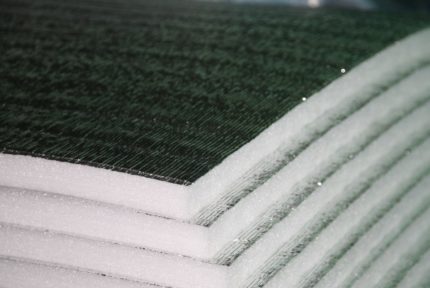
Extruded polystyrene foam can be equipped with foil protection.This option will be an ideal solution for insulation of the garage floor. The presence of a film will provide an additional barrier to cold, protect the material from moisture. Insulation is available in plates, rolls, sheets of different thicknesses.
The use of EPSP provides additional advantages:
- Hygroscopicity - the foil completely overlaps the cellular structure of the insulation, so it cannot absorb moisture. This property is relevant for the insulation of a garage with wooden floors.
- Chemical stability - the level of water pollution, the soil is quite high. The use of foil insulation will extend the life of the material even when they come in contact with acids, alkalis, and other aggressive substances.
- Strength - a special structure, reinforced with a foil layer, allows the extruded polystyrene foam to withstand high loads without deformation.
It is easier to lay expanded polystyrene in rolls on a concrete floor. For a wooden coating, the plates will be the best solution.
Before starting work, we recommend that you familiarize yourself with the features and rules for working with EPS.
Option # 3 - Penoizol
The material is called liquid foam. It will become a practical solution during the construction, reconstruction of the garage.

Due to its liquid form, penoizol provides an absolutely hermetic coating of the entire surface. Its use eliminates the possibility of crevices.
Option # 4 - expanded clay backfill
The material is relatively inexpensive, it is easy to manage with it during installation. Clay raw materials, which remain during the operation of pottery and brick factories, do not burn, are not afraid of temperature changes, and retain heat very well.
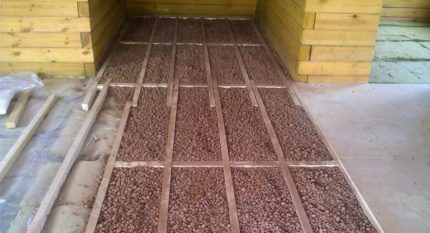
Expanded clay laying is carried out in two ways. The dry method involves falling asleep between the logs of the wooden floor. Wet - the addition of expanded clay to a concrete solution.
Material advantages:
- high sound and heat insulation;
- easy to use;
- does not burn, does not emit caustic smoke;
- not afraid of frost, temperature changes.
Expanded clay - a budget option, acceptable for most rooms. The only negative is the active absorption of moisture, therefore, when arranging the floor, it is important to provide waterproofing.
Option # 5 - mineral wool
The classic insulation is versatile, so it is perfect for the floor in the garage. The material is sold in the form of mats or rolls of various thicknesses, so choosing the optimal solution is not difficult.
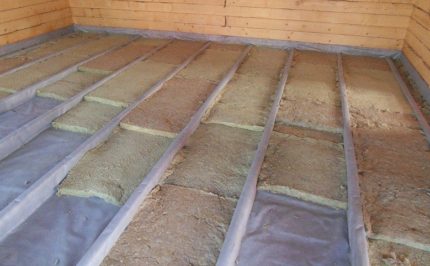
Manufacturers offer glass, basalt, stone and slag wool. Materials differ in the type of raw materials used, operational characteristics.
However, the following are common benefits:
- Low thermal conductivity, the ability to retain heat without giving it away.
- Mineral fibers perfectly absorb sound, providing soundproofing.
- Resistance to damage - the material is recommended for use in wooden structures in which mice can settle. Rodents do not like this stuff. In addition, mineral wool is resistant to mold and mildew.
- Excellent air exchange - mineral wool perfectly passes air.
- Durability - the material does not lose its operational characteristics for a long time, retaining heat for many years.
The ability to select individual slabs or rolls allows you to simplify the process of warming the floor in the garage.
Floor Insulation Instructions
There are a lot of options to insulate the floor in the garage. In most cases, the method that is selected depends on the type of floor.
Installation of insulation is recommended in the warm season - it will be easier to work, and the screed can harden faster.

The plan for the insulation depends on various criteria. The main ones: training, available budget, selected materials.
Garage wooden floor insulation
The most budgetary decision is the use of mineral wool. The material is inexpensive, and installation does not require professional skills, expensive tools.
The procedure for the work is as follows:
- level the soil, pour on it a layer of sand up to 10 cm thick;
- pour in concrete screed;
- lay a waterproofing layer using polyethylene, ruberoid;
- install wooden logs so that the distance between them corresponds to the width of the insulation roll;
- lay mineral wool in the recesses;
- cover the insulation with a layer of waterproofing;
- lay the wood flooring.
Wooden logs can be installed on a base made of expanded clay. Often, foam or extruded polystyrene foam is used instead of mineral wool.
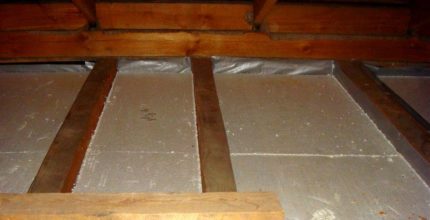
The thickness of the insulating layer or sheets of material should be about 10 cm. If work is done in a finished garage, insulation is reduced to filling the space between the lags with a heat insulator, ensuring its protection from moisture.
Do you have not only a garage, but also the floor in the house is wooden? And you also thought about its insulation? We recommend that you familiarize yourself with work technology thermal insulation.
Concrete work
Stronger concrete floors are preferred by owners of heavy vehicles. High-quality screed ensures long-term operation of the surface. In the event of cracks or insufficient insulation, an additional layer of insulating material can be laid on top of the old one without dismantling.
To create an insulating layer, all the same materials are used, only the rules for their installation are changed. Expanded clay is poured on a rough base with a layer of 25 cm, covered with a reinforcing mesh, and poured with a solution.
When using polystyrene foam, most of the load will be on the foam layer.
To ensure the durability of the structure, you must adhere to the following recommendations:
- When preparing the base, carefully repair all irregularities that can disrupt the insulation layer.
- Overlap the waterproofing film, do not forget about approaching the walls up to 15 cm high. Fix the joints with tape.
- Tightly lay the foam sheets, fix the joints with glue or polyurethane foam.
A film is placed on the insulation layer, which will prevent the penetration of moisture from the solution, then the reinforcing mesh. The design is poured with mortar.
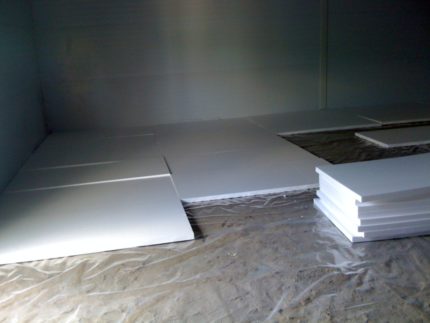
If necessary, heating the garage in some cases is installed water heated floor. As a heater, then foil polystyrene foam is used.
Integrated into the design pipesalong which the coolant circulates, providing heating.
The best ways to heat a garage we covered in next article.
When planning floor insulation in a garage, it is worth considering an inspection hole - its presence facilitates maintenance and car repair. However, it becomes a serious channel for heat leakage. Performing work with the floor, do not forget about its thermal insulation.
The complexity of the device of modern machines leads to the fact that owners less and less independently carry out various works, so the pits are not used for their intended purpose. As a result, they are closed with homemade plugs, warming with improvised materials. If there is a difference in the quality of thermal insulation of the floor and the pit, condensation may form at the point of temperature difference.
Conclusions and useful video on the topic
You can insulate the floor in the garage yourself. A selection of videos will help to understand in detail the order of the work.
The first video tells about the insulation of a wooden floor in a garage:
The video below describes the procedure for working with a concrete floor, the possibility of laying additional heating:
The last video was prepared by experts and will tell you about the nuances of floor insulation using extruded polystyrene foam:
In order for the result of floor insulation to provide the desired temperature regime, it is important to adhere to the technology and rules for installing heat-insulating material, to study the recommendations of professionals. Observing the laying technology, you can get a high-quality coating that will last for many years.
If you already have experience of independent insulation of the garage floor, share your achievements in the comments. If you have not yet decided on the type of insulation, do not know which technology to choose, ask questions in the comment block - let's discuss together options, their advantages.

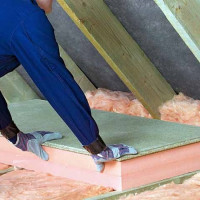 Ceiling insulation in a house with a cold roof: types of effective heaters + installation instructions
Ceiling insulation in a house with a cold roof: types of effective heaters + installation instructions 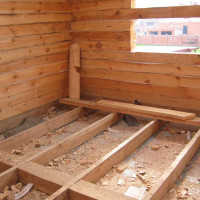 Floor insulation by logs: materials for thermal insulation + insulation schemes
Floor insulation by logs: materials for thermal insulation + insulation schemes 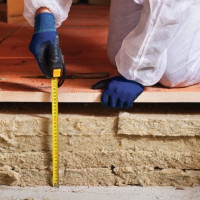 Warming of a wooden floor: popular insulation technologies + expert advice
Warming of a wooden floor: popular insulation technologies + expert advice 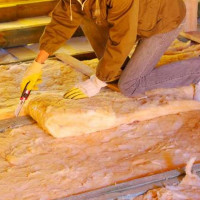 Floor insulation in a wooden house: work procedure + popular heaters
Floor insulation in a wooden house: work procedure + popular heaters 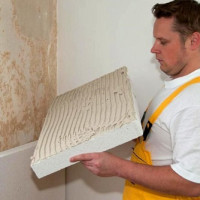 Types of insulation for the walls of the house from the inside: materials for insulation and their characteristics
Types of insulation for the walls of the house from the inside: materials for insulation and their characteristics 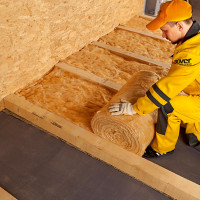 Insulation for the floor in a wooden house: materials for thermal insulation + advice on choosing insulation
Insulation for the floor in a wooden house: materials for thermal insulation + advice on choosing insulation  How much does it cost to connect gas to a private house: the price of organizing gas supply
How much does it cost to connect gas to a private house: the price of organizing gas supply  The best washing machines with dryer: model rating and customer tips
The best washing machines with dryer: model rating and customer tips  What is the color temperature of light and the nuances of choosing the temperature of the lamps to suit your needs
What is the color temperature of light and the nuances of choosing the temperature of the lamps to suit your needs  Replacement of a geyser in an apartment: replacement paperwork + basic norms and requirements
Replacement of a geyser in an apartment: replacement paperwork + basic norms and requirements